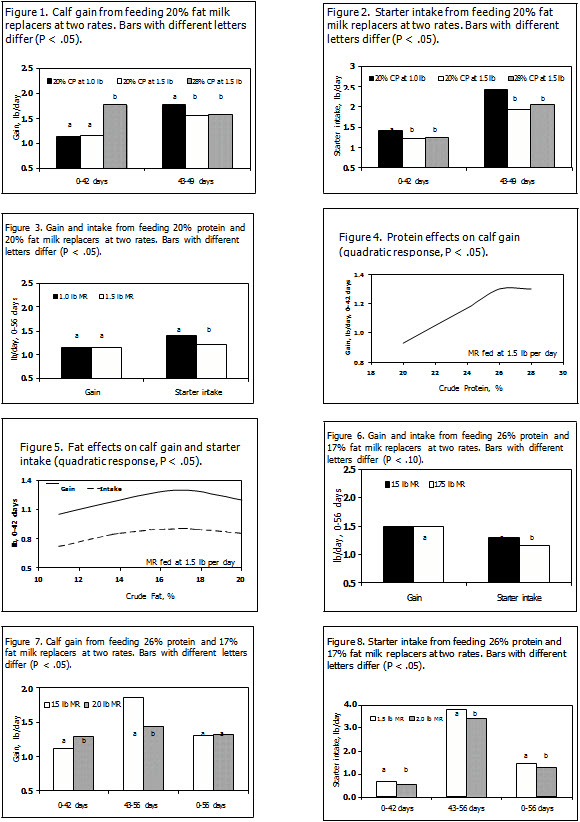Milk Replacer Research Feeding Rate
rfadank posted on August 28, 2010 07:15
Previous research in our nursery has lead us to recommended feeding rates for two of our common milk replacers (MR). White Gold MR, which is 20% milk protein and 20% fat, is to be fed at 1.0 lb of powder per head daily. Pinnacle MR, which is 26% milk protein and 17% fat, is to be fed at 1.5 lb of powder per head daily.
20% protein and 20% fat (White Gold) MR
Several years ago we fed high stress, commingled calves, 1.0 and 1.5 lb of a 20% protein, 20% fat MR or 1.5 lb of 28% protein, 20% fat MR. There was no difference in gain between calves fed 1.0 and 1.5 lb of the 20% protein MR (Figure 1). Calves fed 1.5 lb of the 28% protein MR gained faster than calves fed the 20% protein MR. Calves fed
1.5 lb of either the 20% or 28% protein MR consumed less starter than calves fed 1.0 lb of MR (Figure 2). These data demonstrate the need for increasing protein above 20% when feeding more than 1.0 lb of MR powder.
Recently, we fed low stress, single source calves 1.0 or 1.5 lb of a 20% protein, 20% fat MR during moderate temperatures in the fall. We saw the same results as with the high stress calves several years ago. Calves fed 1.5 lb of MR did not gain faster and consumed less starter than calves fed 1.0 lb of MR from 0 to 56 days (calves were weaned at 42 days; Figure 3). Calves fed 1.5 lb of MR grew faster the first 28 to 35 days but slower the last 21 to 28 days than calves fed 1.0 lb of MR.
Using the dairy NRC (2001) calf model to predict gains, protein limits gains in MR fed at
1 lb daily. This is consistent with body composition data of Diaz et al. (2001) and Blome et al. (2003) in calves fed only MR (no starter). Data from Tikosky et al. (2001) and Bartlett et al. (2002) would suggest that if a 20% fat MR was fed at rates of about 1.5 lb daily, the calf would fatten rather than increase protein body mass.
Collectively, these data are consistent. A 20% protein, 20% fat MR (like White Gold)
should be fed at 1.0 lb daily during non-cold stress seasons.
26% protein and 17% fat (Pinnacle) MR
When feeding MR at rates over approximately 1 lb of powder daily, protein must be elevated to approximately 26% CP, as the dairy NRC (2001) calf model, carcass lean growth data from Cornell University (Diaz et al., 2001) and the University of Illinois (Blome et al., 2003), and BW gain data from our lab (Hill et al., 2001; Figure 4) suggests. However, the challenge is in getting calves to consume dry starter when MR powders are fed at high rates. Our data would suggest that 20% fat is too high and contributes to depressions in starter intake (Hill et al., 2001; Figure 5). Data from Cornell University (Tikosky et al., 2001) and the University of Illinois (Bartlett et al., 2002) suggest that 20% is too high and contributes to excess fat gain and deposition in the carcass. Powders with 15 to 17% fat are more appropriate. Several years ago, we fed high stress, commingled calves, 1.5 and 1.75 lb of a 26% protein, 17% fat MR. There was no difference in gain between groups of calves but calves fed 1.75 lb of MR tended to consume less starter than calves fed 1.5 lb of MR (Figure 6).
Recently low stress, single source calves were fed 1.5 or 2.0 lb of a 26% protein, 17% fat MR during moderate temperatures in the fall. We saw the same results as with the high stress calves several years ago. Calves fed 2.0 lb of MR did not gain faster and consumed less starter than calves fed 1.5 lb of MR from 0 to 56 days (calves were weaned at 42 days; Figures 7 and 8). Calves fed 2.0 lb of MR grew faster the first 35 to
42 days but slower the last 14 days than calves fed 1.5 lb of MR.
Feeding rates exceeding approximately 1.5 lb of powder during non-cold stress weather depress starter intake and create a slump in growth during the weaning process and post-weaning that negates some of the fast gains obtained prior to weaning.
References
Blome, R. M., J. K. Drackley, F. K. McKeith, M. F. Hutjens, and G. C. McCoy. 2003. Growth, nutrient utilization, and body composition of dairy calves fed milk replacers containing different amounts of CP. J. Anim. Sci. 81:1641-1655.
Diaz, M. C., M. E. Van Amburg, J. M. Smith, J. M. Kelsey, and E. L. Hutten. 2001. Composition of growth of Holstein calves fed milk replacer from birth to 105-kilogram body weight. J. Dairy Sci. 84:830-842.
Hill, T. M., J. M. Aldrich, A. J. Proeschel, and R. L. Schlotterbeck. 2001. Feeding neonatal calves high levels of milk replacers with different protein and fat levels. J. Dairy Sci. 84 (Suppl.
1):265 (Abstr.).
Jasper, J. and D. M. Weary. 2002. Effects of ad libitum milk intake on dairy calves. J. Dairy
Sci. 85:3054-3058.
National Research Council. 2001. Nutrient Requirements of Dairy Cattle. 7th rev. ed. Washington, D.C. National Academy Press.
Tikofsky, J. N., M. E. Van Amburgh, and D. A. Ross. 2001. Effect of varying carbohydrate and fat content of milk replacer on body composition of Holstein bull calves. J. Anim. Sci. 79:2260-
2267.


